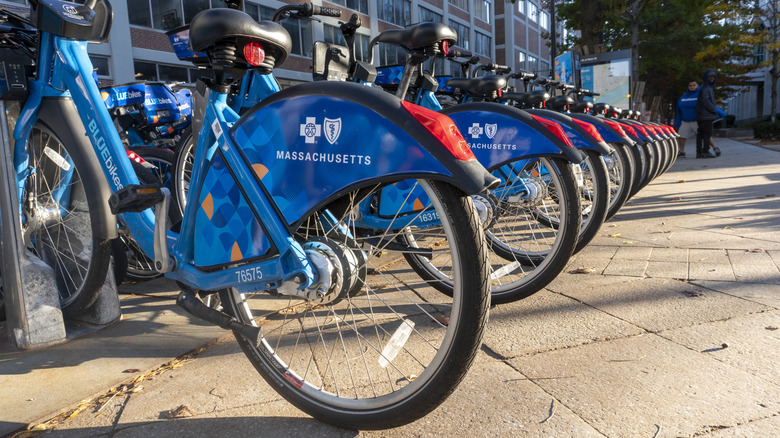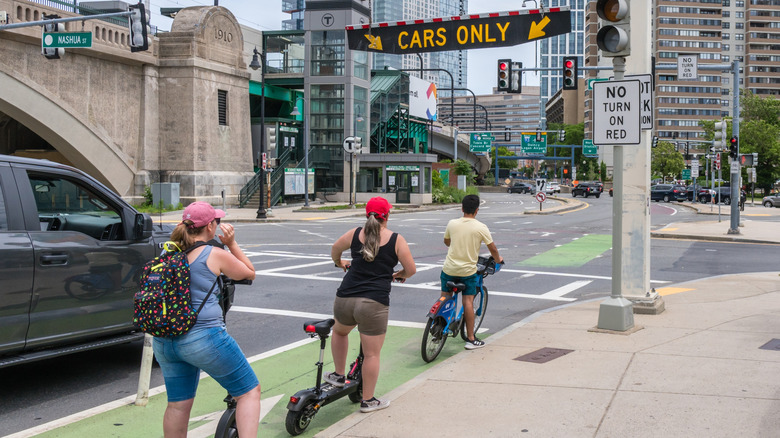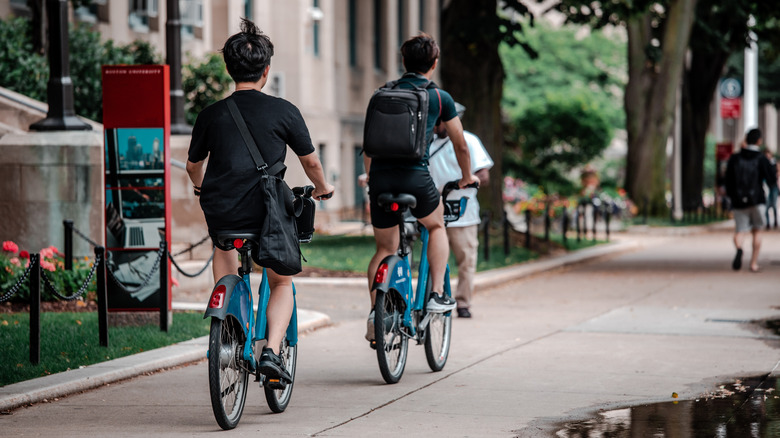Why You Might Want To Think Twice About Renting A Bluebike In Boston
Before we say anything else, let's be clear: Bluebikes is a great program, and Boston is a better city because of it. This bike-share network kicked off in 2011, back when it was called Hubway, and more than a million rides were taken within the first two years. Bluebikes has helped normalize cycling, reduce traffic, and provide efficient transport for inner-city Bostonians with places to go and people to see. Unlike so many bike-share systems, Bluebikes is municipally owned, so most of the subscription and rental fees stay local. In a city that has never been easy to get around, this initiative maintains a fleet of more than 4,000 bikes, which are parked at 450 stations across 13 municipalities. This is an amazing feat, and something Massachusetts should be proud of.
That said, first-time tourists shouldn't expect to just jump on a Bluebike and go, especially if they're not confident urban riders. Boston is confusing, congested, unforgiving, and downright dangerous to ride in, even if you know the city well. The same goes for satellite communities like Cambridge and Somerville, which will all feel like the same city to newcomers; the whole metropolitan area can feel like it's conspiring to destroy you, and the minimalist Bluebikes may seem ill-prepared for the curbs, potholes, cracked pavement, hairpin turns, sudden stops, red-light-running cars, and general mayhem that await you at every block and intersection. Most visitors will take this historic New England walking route, while others will puzzle out Boston's train system, the T. Many hardened souls will drive through Beantown in a car, braving some of the most hair-raising traffic in the Northeast. Finally, a few will try Bluebikes, which are also available to anyone with an app. But be warned: Pedaling around Boston is hard.
Bluebikes: Experienced riders wanted
Partly, Bluebikes are simple machines that have neither suspension nor sophisticated gear cassettes. Standard bikes have some useful features, like baskets, bells, and continuous shifters, which are all great for urban cycling. But they also weigh about 45 pounds, which is pretty husky for a commuter bike, and the e-bikes weigh considerably more. This is pretty common for bike-share models, which need to be sized and sturdy enough for a wide range of body types; heavier bikes are also harder to steal, which is always a risk. Still, it's one thing to pedal a hefty machine through a flat city like Minneapolis, where the streets are flat, gridded, and blessed with 98 miles of separated bike lanes; it's quite another to navigate a city that many people believe was based on cow paths — and logged 10,616 potholes in 2024 alone (according to The Boston Globe). Don't get us started on what Green Line trolley tracks can do to your rims if you ride over them too hard.
"Bluebikes are for experts," wrote Sharon Kong-Perring in a 2024 article in The Travel. "You really need to be a decent bike rider to safely use the Bluebikes. Not all roads have a safe bike lane, and car drivers aren't always the most aware when it comes to sharing the street with bikers." She adds that many cyclists are irresponsible as well, making the situation even worse: "...bicyclists on rented Bluebikes who dart into traffic, don't abide by traffic laws, or don't wear protective gear. If you aren't comfortable on a bike, then it's much safer to walk or take the train."
How to enjoy bike riding in Boston
But what if you are a seasoned urban cyclist? The Boston area is still tricky, yet active visitors may be surprised by what they find: at least 59 miles of off-street paths and 17.5 miles of separated bike lanes, with plans to add 10 more miles in the near future. The Charles River Bike Path is a 23.7-mile loop that extends from the distant suburb of Waltham to the Museum of Science in downtown Boston, with lovely forest and dynamic river views all along the way. Cambridge, which is directly across the river from Boston and is basically indistinguishable to most tourists, regularly tops lists for "best city to ride a bike," largely thanks to cycling infrastructure and local enthusiasm for pedal-power. All the above dangers still exist, and Bluebikes can still feel clunkier than, say, a carbon-framed racing bike, but if you're experienced and prepared, they'll absolutely suffice.
The Boston area is also home to a feisty cycling community, including the Charles River Wheelers, the nonprofit Bikes Not Bombs, and Boston Bike Party, a free monthly group ride that regularly attracts 1,000 or more attendants. Once you adapt to local traffic patterns and know where the routes link up (and don't), a Bluebike is a terrific way to enjoy these initiatives and make local friends — always a nice excuse in a famously unfriendly town. With so many museums, historical landmarks, and global eateries to visit, an app-based bicycle system is the perfect means of seeing it all. Just, please, get yourself a helmet.


